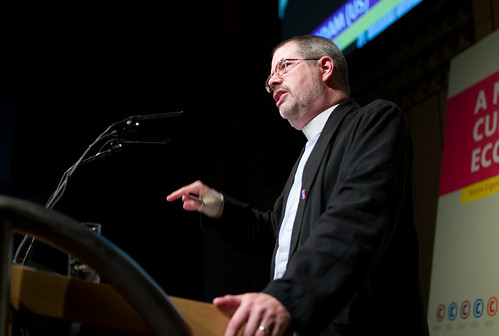Truth Is Noisy
David is summarizing a correspondence theory of truth, and its function as a mirror of nature. Because this world-mirroring function of truth is scarce, we want to own it. Moreover, since the messy world is always changing, we tend to desire truths that escape change and contingency — eternal, syllogistic truth. This generates a deep alienation from the world, since the representations that constitute our formally “true” version of are abstract and insulated from the real world that these supposedly represent. [As David always says, “Live blogging. Poorly. Omissions, typos, mistakes. That’s just the way it is.”]
This corresponds in an interesting way to the broadcast culture that has developed in the industrial West: it broadcasts representations into our brain. One-to-many media conform to the characterization David gave of correspondence theory: broadcast power is scarce, it aims at universality, and so on.
In the information age, we can construct digital models; these externalize the representations of the world that we theorize.
That leads to conceptual confusion such that Ray Kurzweil proposes the Singularity, at which point computer-storage capacity advances to the point that representations of our neural content can be uploaded to digital storage media, and our physical embodiment becomes dispensable.
This all goes back to Claude Shannon’s information theory. The diagram he proposed
treats the medium of information as indifferent, and focuses on the contrast between message and noise. Noise is to information as “mere information” is to truth. Their outlook has been shaped by the function of information theory in transmitting commands under battle conditions (where real noise threatens to obscure real commands) and Shannon’s diagram takes the exceptional condition of battle communication and uses it as a model for the general condition. It’s a classic error: taking the exceptional as a model for the ordinary. David points out that the only time “the world” appears in the diagram is as noise, as the distraction, distortion, recalcitrant opposite of truth (or pure communication).
David notes that the Web is (in a sense) all noise, all difference, the opposite of Shannon’s “pure communication.” He points to the best source for learning about Sarah Palin: not just Wikipedia’s main page, but specifically the talk page that displays the discussions and evidences and rationales that justify the main page.
Although each instantiation of the Wikipedia tends toward homogeneity — the interactions among different-language versions of the Wikipedia provide for, and generate, the juxtaposition of different accounts of truth.
And in the end, this concatenation of difference is more truthful than the homogeneous universality of the broadcast, correspondence-theory version of truth. The truthful network is linked, persistent, open to all, open to everything [side note: the server at breakfast this morning invited me to “sit everywhere”], increasingly sympathetic, never complete.
With the correspondence theory of truth, difference is antithetical to peace; the netty version of truth provides for the heterogeneity that sustains peace.
(Speaking of David, he remarked during dinner last night that My Hundred Million Dollar Secret had sold about two dozen copies — of which, I may say, Margaret and I bought a bunch. Seriously, it’s a well-written, winsome narrative exploration of very significant questions in ethics. I recommend it to YA readers, to parents of young adults, to teachers of young adults, to teachers of adolescents who are hiply ironic enough to read stories skewed toward younger readers, and pretty much anyone else. Buy a copy, assuage David’s authorial disappointment!]


